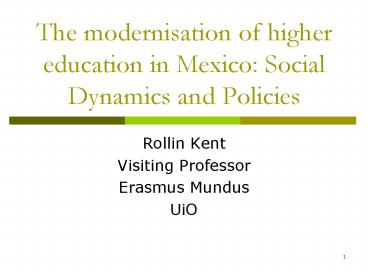The modernisation of higher education in Mexico: Social Dynamics and Policies - PowerPoint PPT Presentation
1 / 17
Title:
The modernisation of higher education in Mexico: Social Dynamics and Policies
Description:
Mediocre performance (3% - 4% growth) Limited labor market growth. Increasing ... Inequitable growth: poor students from low quality preparatory schools end up ... – PowerPoint PPT presentation
Number of Views:45
Avg rating:3.0/5.0
Title: The modernisation of higher education in Mexico: Social Dynamics and Policies
1
The modernisation of higher education in Mexico
Social Dynamics and Policies
- Rollin Kent
- Visiting Professor
- Erasmus Mundus
- UiO
2
- Themes
- Demographics the force of numbers
- Economic shifts and shocks
- Expansion of higher education the processes and
policies - Some paradoxes and emerging issues
3
1. The force of numbers
4
Demographic growth in Mexico in the 20th century
5
The evolving demographic growth rate
6
(No Transcript)
7
2. Economic shifts and shocks the roller coaster
economy and chronic low growth
8
- The Mexican Miracle, 1946-1982 protectionist,
state-led growth of 6 or more - The long debt crisis, 1982-1989 stagflation,
freeze on public spending, political conflict - The neoliberal shift NAFTA 1989 the present
- Privatization, liberalization abrupt exposure to
international competition - Some industry has responded
- Small scale agriculture was hit hard
- And the 1994-96 peso devaluation set growth back
several years
9
- Today the low growth - inequality trap
- Mediocre performance (3 - 4 growth)
- Limited labor market growth
- Increasing income gap
- Massive emigration to the US
- Monopolistic economic structure
- NAFTAs advantages are eroding in the face of
more competitive emerging economies (China,
India) - Ineffective democratization we have democracy
but what good does it do?
10
3. Expansion of higher education the chief
processes
11
The 1970s early 1980s
- Rapid, unplanned enrollment expansion
- Improvised growth of the academic profession
- Bureaucratization and politicization
- Low institutional differentiation massification
of public universities
12
(No Transcript)
13
The crisis of the 1980s
- Freeze on public funding (salaries,
infrastructure, maintenance, research) - Expansion of private H.E.
- Brain drain
- Profound shift in the cultural climate
- Ferocious critique of unregulated public sector
expansion - Privatization is good equitable, efficient,
provides choice, flexible, relevant)
14
Modernization of H.E. 1990 to the present
- Focus on quality (as opposed to growth)
- Restriction on access to public universities
- Institutional differentiation
- New public two and four year technical institutes
in outlying regions - Lax regulation of private sector expansion
- Evaluation accreditation
- More diversified contract funding, although
political budget negotiation is still the rule - Strategic planning since 2001
- Focus on excellence in research
- Rapid expansion of graduate education
15
4. Some paradoxes and new issues
16
- Vast unregulated private sector issues of
quality, price and equity - Inequitable growth poor students from low
quality preparatory schools end up paying for bad
private H E - New controls for autonomous public universities
more rigidity but also deeper institutionalization
in the face of a turbulent environment. - A challenge institution-wide coordination in the
face of varying internal responses to
modernization - Considerable expansion of the science system but
poor RD performance, as measured by current
indicators
17
- New growth pressures in the offing expansion of
unregulated low quality preparatory education - Fiscal squeeze increasing demands on public
resources (pensions, policing security, health)
but very low rate of fiscal collection (12 of
GDP) - Policy is continuously overwhelmed by society
strong society, weak state?































